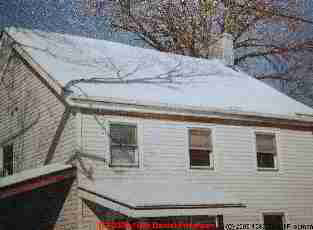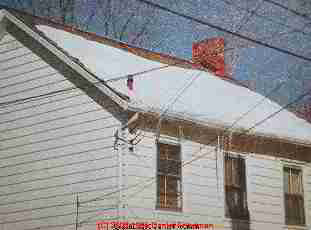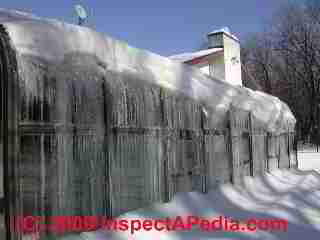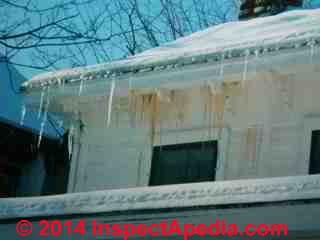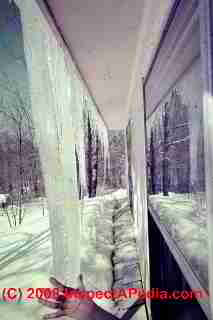 Roof Ice Dam Prevention
Roof Ice Dam Prevention
Comparing Houses With & Without Roof Ventilation Shows How to Stop Roof Ice Dams & Ice Dam Leaks
- POST a QUESTION or COMMENT about methods for preventing ice dam leaks and ice formation on roof edges
This roof ventilation and ice dam leak prevention article compares Two Identical Houses, With and Without Roof Ventilation and Insulation to Understand Attic Moisture Problems. Both homes, located in "the Bleachery" in Wappingers Falls, NY were built in the late 1800's overlooking Wappingers Lake.
This article is part of our roof ventilation & attic condensation article series. These articles describe inspection methods and clues to detect roof venting deficiencies, insulation defects, and attic condensation problems in buildings. It describes proper roof ventilation placement, amounts, and other details. The photograph at page top shows the author's introduction to roof ice dams at 25 King Drive in Poughkeepsie, NY in 1970.
InspectAPedia tolerates no conflicts of interest. We have no relationship with advertisers, products, or services discussed at this website.
Comparing Two Identical Houses, With and Without Roof Ventilation and Insulation to Understand Attic Moisture Problems
One of these pre-1900 homes (at below left) was renovated by the author (DJF) to include effective soffit intake and ridge exhaust under-roof venting along wtih insulation and air leak sealing throughout the structure. The second home (below right) had a drafty attic that had avoided attic condensation and moisture troubles but the design sucked so much heat out of the home in winter that combined with little attic insulation the house suffered from extensive ice dam formation.
On two identical 1860's Wappingers Falls NY "Bleachery" historic houses shown in these photos, the one with no melted snow was renovated to include continuous soffit and ridge venting and good attic insulation.
[Click to enlarge any image]
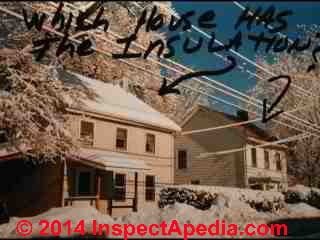 Look at the difference in the two roofs on the same winter day.
Look at the difference in the two roofs on the same winter day.
These homes, located on West Street in the village of Wappingers Falls, New York, were built to house workers at nearby mills powered by water from Wappingers Creek.
At left you can see the same two homes on a different winter day. The home on the left was the one to which we'd added attic insulation and under-roof venting. The home on the right has so much heat loss through the roof that it is completely free of snow.
When the homes were built they lacked central heating, storm windows, siding, caulking, and insulation. They were drafty. Interior moisture and condensation were less likely to damage the structure than today, nearly 130 years later, when the energy improvements listed have been added to the homes, making them tighter but also providing indoor moisture sources such as from bathing or cooking.
In renovating the left-hand home we removed solid blocking between rafters at the house eaves, allowing perforated soffit covering to send air in at the eaves.
Adding a ridge vent completed the air intake-outlet scheme. Insulation was placed in the attic floor and we used baffles to be sure that we kept an air path open at the house eaves.
It was important to contine the attic floor insulation out over the top plate to avoid a heat loss point that would have invited icing over that area.
Photos of of Ice-damaged Roofs & Leaks into Building Walls Indicate Where Roof Ice and Ice Dams are a Problem
This glass solarium suffers from ice build-up during most winters.
The ice action led to damage to the glass seals, resulting in leaks into the building.
If a roof shape prevents easy installation of under-roof venting, or if a home is located where building custom excludes under-roof venting, use of an ice-and-water shield product under the shingles at roof edges, or use of metal covering the lower roof slopes are other measures taken to prevent ice dam leaks into the building interior.
See UN-VENTED ROOF SOLUTIONS for a discussion of how we prevent leaks into roofs where venting is difficult to achieve.
In our next photo below you can see examples of leaks into building walls caused by roof ice dams and water back-ups behind the dams that leak into the building soffits and walls. It can be hard to spot this problem in warm weather, but freezing weather, by forming ice at wall leak points, adds actual ice to the clues.
In warmer weather when there is no snow or roof ice there are still clues indicating leaks into building walls. From outside look for stains or for water tracks down walls subject to water damage from roof leaks or roof ice dam backup leaks. Inside be alert for mold complaints and hidden mold reservoirs.
Loss of insulation R-value due to wet wall insulation also shows up on thermal scans if the insulation is still wet.
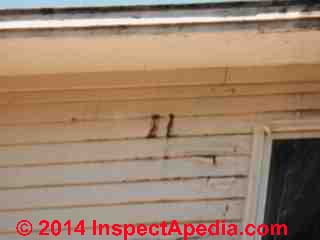 or select a topic from the closely-related articles below, or see the complete ARTICLE INDEX.
or select a topic from the closely-related articles below, or see the complete ARTICLE INDEX.
The house whose roof shows melted snow and bare roof slates (beware of nasty owner) has inadequate venting and inadequate insulation, giving rise to snow melt and ice damming, and almost certainly to attic condensation and moisture.
The house whose roof is covered with a uniform blanket of un-melted snow, (renovated by the author) was improved to add attic insulation in the attic floor as well as continuous soffit intake venting and ridge outlet venting.
After these vents were added we also closed-off the gable end vents (not shown) to assure that airflow moved over the desired pathway.
The builders of this house had blocked the soffits with boards on edge between each rafter pair in an effort to "warm up" the cold attic. We removed these blocking boards to assure a proper airflow.
Global warming and building ice dam leaks? Venting of roof cavities helps reduce the effects of hot weather associated with global warming
In a 1996 version of this article in the Journal of Light Construction we paraphrased Stephen Jay Gould, a Harvard scholar who said "The world is currently enjoying a brief warm spell in the midst of a basically cool period.
Gould said that the glaciers that covered our region might return in another 10,000 years or so. We added that the sheets of ice we see creeping down buildings in freezing climates are not due to global freezing but due to poor building ventilation and insulation.
That conservative view of climate change has since proven to be mistaken, as very rapid global warming is, in 2008, a fact accepted by virtually every qualified scientist. But global warming does not mean that we can blithely ignore attic ventilation. Not only will the risk of ice dam leaks continue to occur on poorly-insulated and poorly-ventilated building roofs, but more, the benefits of proper under-roof ventilation are present in hot weather as well.
A properly ventilated building roof cavity or attic means that the roof surface as well as the attic will be cooler in hot weather, reducing indoor cooling costs and extending the life of the roof covering.
...
Continue reading at HEAT TAPES & CABLES for ROOF ICE DAMS for examples of emergency or permanent use of heating tapes and de-icing kits to stop roof ice dam leaks, or select a topic from the closely-related articles below, or see the complete ARTICLE INDEX.
Or see these
Recommended Articles
Suggested citation for this web page
ROOF ICE DAM CURE: Comparing Two Houses at InspectApedia.com - online encyclopedia of building & environmental inspection, testing, diagnosis, repair, & problem prevention advice.
Or see this
INDEX to RELATED ARTICLES: ARTICLE INDEX to BUILDING VENTILATION
Or use the SEARCH BOX found below to Ask a Question or Search InspectApedia
Ask a Question or Search InspectApedia
Try the search box just below, or if you prefer, post a question or comment in the Comments box below and we will respond promptly.
Search the InspectApedia website
Note: appearance of your Comment below may be delayed: if your comment contains an image, photograph, web link, or text that looks to the software as if it might be a web link, your posting will appear after it has been approved by a moderator. Apologies for the delay.
Only one image can be added per comment but you can post as many comments, and therefore images, as you like.
You will not receive a notification when a response to your question has been posted.
Please bookmark this page to make it easy for you to check back for our response.
Our Comment Box is provided by Countable Web Productions countable.ca
Citations & References
In addition to any citations in the article above, a full list is available on request.
- Eric Galow, Galow Homes, Lagrangeville, NY. Mr. Galow can be reached by email: ericgalow@gmail.com or by telephone: 914-474-6613. Mr. Galow specializes in residential construction including both new homes and repairs, renovations, and additions.
- In addition to citations & references found in this article, see the research citations given at the end of the related articles found at our suggested
CONTINUE READING or RECOMMENDED ARTICLES.
- Carson, Dunlop & Associates Ltd., 120 Carlton Street Suite 407, Toronto ON M5A 4K2. Tel: (416) 964-9415 1-800-268-7070 Email: info@carsondunlop.com. Alan Carson is a past president of ASHI, the American Society of Home Inspectors.
Thanks to Alan Carson and Bob Dunlop, for permission for InspectAPedia to use text excerpts from The HOME REFERENCE BOOK - the Encyclopedia of Homes and to use illustrations from The ILLUSTRATED HOME .
Carson Dunlop Associates provides extensive home inspection education and report writing material. In gratitude we provide links to tsome Carson Dunlop Associates products and services.


